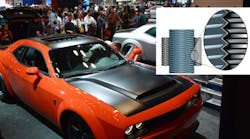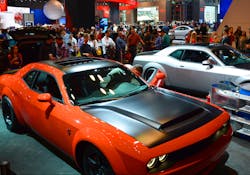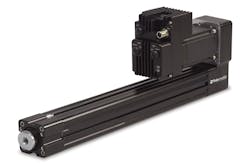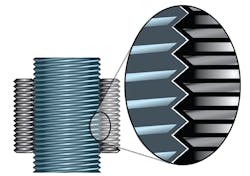The marketing geniuses at Fiat-Chrysler Automotive (FCA) knew they had a tiger by the tail with the 840-hp V8-powered Dodge SRT Demon. They wanted the motoring public to experience the thrill of driving one of these street rockets, but they weren’t eager to have every prospective buyer or aspiring street racer actually test drive one.
So, they decided to go with the next best thing: a pair of side-by-side Dodge SRT Demon simulators that could be featured at auto shows. The public (and prospective buyers) could compete in head-to-head drag racing competition, complete with a working array of starting lights known as a “Christmas tree” between the two cars.
Two Dodge SRT Demons serve as driver cockpits for a drag-racing simulator built by Sigma Integrale that can be seen at auto shows and NHRA races.
To build the simulators, FCA turned to Sigma Integrale, a small California company that earned a reputation for building top-notch vehicle simulators that recreate the driving experience in high-performance go-kart and racing cars, and even big-rig trucks.
Sigma’s simulators let a driver sit in a realistic chassis and “race” in a virtual environment against the clock, the computer, or other drivers, and they could be anywhere around the world. Sigma was also well-known for offering drivers a realistic ride, thanks to a motion-control subsystem that faithfully recreates the bumps and turns on the track and the accelerations, steering, and braking inputs from the driver.
Recreating the feel of accelerating in the Dodge SRT Demon, however, was an engineering challenge a magnitude greater than those Sigma had overcome before. The Demon goes from 0-to-60 mph in just 2.3 sec. and generates about 1.8 g’s off the line, enough force to lift the car’s front end off the ground. In fact, Sigma determined that to recreate this movement, the simulators would each need four fast and powerful actuators in the suspension, two in front and two in back, for the necessary force and lift.
To make the simulator “jump” off the line, two RSA electric rod-style actuators from Tolomatic in each Demon generates 2,000 lb of force to lift the front ends of the cars 12 inches in a fraction of a second.
“We needed 12 inches of lift in the front end of the car to simulate the off-the-line acceleration, and the only way to do it was with brute force,” says Sigma’s head of engineering, Howard Lin. “That meant replacing suspension parts with electric actuators that could each generate 2,000 pounds of force and lift the front end 12 inches in a fraction of a second.”
Sigma initially considered using hydraulic or pneumatic rams to meet the force and speed requirements, but rejected them because they wanted precise control and didn’t really want the potential risks associated with hydraulic and pneumatic controls, especially in a traveling display for auto shows. That left electric actuators.
By now, Lin had a list of critical features for the actuators. First, they had to be powerful and quick. Next, they had to fit in the space inside the suspension’s coil spring normally occupied by shock absorbers. They also had to be programmable and be reliable with little or no maintenance needed. After a thorough search, Lin selected RSA electric rod-style actuators with roller-screws from Tolomatic.
The electric actuators are small enough to fit in the same space normally occupied by the Demon’s shock absorbers.
Aaron Dietrich at Tolomatic explained that roller-screw actuators offered the highest thrust, lowest maintenance, and best reliability of all electric rod actuators. “In general, screw mechanisms produce linear motion by turning either the screw or nut in an assembly,” he says. “The screw is a cylindrical element that has threads; the nut is a matching element that rides on the screw. Each component can rotate independently upon the other. To create linear motion, you restrain the screw or the nut.
“A roller screw transmits force through several threaded rollers in the nut,” Dietrich continues. “These rollers turn within the nut while riding on the screw’s threads. With numerous rollers, there are significantly more contact points with the screw in the same space compared to other types of screws. This generates and transmits high forces in a small package with a longer life than other screws with similar force.”
Lin chose roller screw actuators for the Dodge SRT Demon project because of their performance, but also because of Tolomatic’s helpful design tools, such as actuator sizing software and downloadable CAD drawings to help customers specify the proper components.
The RSA actuator from Tolomatic use roller-screws to transmit force through several threaded rollers in the nut. This provides significantly more contact points with the screw and results in the ability to transmit high forces in a compact package.
The finished product has two side-by-side Dodge SRT Demons (minus drive trains). In front of each stands a large video screen of the quarter-mile track. During the simulated drag race, when the driver sees the green light and hits the gas, the front end rises 12 in. and then drops in steps as the driver goes manually through the gears.
The rate of rise and drop are proportional to driver inputs on the gas and clutch. Sound effects make it even more realistic. When the driver brakes at the end of the quarter-mile run, the nose of the car dives and the rear end rises in response until the car comes to a “stop.”
The simulators have since appeared in five national auto shows and 24 National Hot Rod Association races. To date, 57,600 “drivers,” along with 25,000 “passengers” have taken the quarter-mile joyride in the simulators have been “driven” and been lifted by the actuators. Each driver gets to run the drag race three times, so the actuators have lifted and cycled the cars through their simulated drag races a total of 172,800 times.
According to Lin, the project’s success speaks for itself. “After nearly 87,000 cycles, we never had to repair the actuators and never had a failure,” he says. “In fact, we only bought a total of eight actuators for the two cars, and they survived thousands of cycles of torture testing in our shop in addition to the continuous torture at the auto shows.”
The Dodge team plans on taking the Sigma simulator plans a third season for the SRT Demon drag race simulator at this year’s NHRA races.














